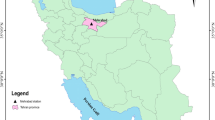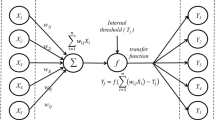Abstract
The aim of this study was to review different literatures to assess the applicability of artificial neural network in predicting temperature. Temperature prediction as part of weather prediction involves the application of science and technology to predict the state of temperature for a future period in a specific location. Artificial neural network (ANN) has been found to be a promising tool to be used in temperature prediction because it is able to handle complex and nonlinear physical variables of the atmosphere. The use of ANN for prediction of weather elements has shown significant improvements in prediction and accuracy. The performance of the ANN model varies depending on the nature and number of input data used in training the network, the number of neurons in the hidden layer, architecture of a network, transfer function and on the training algorithms. The choice of ANN architecture and the type of data depend on the nature of the problem to be addressed. ANN is therefore found to be a powerful tool in predicting temperature of a specific place, provided input parameters of the model are well chosen.



Similar content being viewed by others
Explore related subjects
Discover the latest articles and news from researchers in related subjects, suggested using machine learning.References
Abbot J, Marohasy J (2014) Input selection and optimisation for monthly rainfall forecasting in Queensland, Australia, using artificial neural networks. Atmos Res 138:166–178
Abhishek K, Singh MP, Ghosh S, Anand A (2012) Weather forecasting model using artificial neural network. Proced Technol 4:311–318
Ahmad R, Lazin NM, Samsuri SFM (2014) Neural network modeling and identification of naturally ventilated tropical greenhouse climates. Wseas Trans Syst Control 9:445–453
Andri A, Mahardhika P, Edwin L, Yew SO (2019) Devdan: deep evolving denoising autoencoder. Neurocomputing 390:297–314
Anekwe F, Onuchukwu C (2017) Study of the variation in weather parameters in some selected cities in Southern Nigeria. COOU J Multidiscip Stud 1:122–132
Ashrafi K, Shafiepour M, Ghasemi L, Najar AB (2012) Prediction of climate change induced temperature rise in regional scale using neural network. Int J Environ Res 6(3):677–688
Bani-ahmad S, Alshaer J, Al-oqily I (2014) Development of temperature-based weather forecasting models using neural networks and fuzzy logic. Int J Multimed Ubiquitous Eng 9(12):343–366
Cachim P (2010) Temperature prediction in timber using artificial neural networks. In Proceedings of 2010 world conference on timbre engineering pp 1–5
Chaturvedi DK (2008) Factors Affecting the performance of artificial neural network models. Techniques and its Applications in Electrical Engineering, Soft Computing, pp 51–85
Chiang H, Chen M, Huang Y (2019) Wavelet-based EEG processing for epilepsy detection using fuzzy entropy and associative petri net. IEEE Access 7:103255–103262
Chu WT, Ho KC, Borji A (2018) Visual weather temperature prediction. In Proceeding of 2018 IEEE Winter Conference on Applications of Computer Vision pp 234–241
Coulibaly P, Dibike YB, Anctil F (2005) Downscaling precipitation and temperature with temporal neural networks. J Hydrometeorol 6(4):483–496
Culclasure A (2013) Using neural networks to provide local weather forecasts. Southern University, Georgia
Darj M, Dabh V, Prajapati H (2015) Rainfall forecasting using neural network: a survey. In Proceedings of International Conference on Advances in Computer Engineering and Applications (ICACEA) pp 706–713
David N, Rajagopalan B, Zagona E (2003) Regression model for daily maximum stream temperature. J Environ Eng 129(7):667–674
Dombaycı ÖA, Önder Ç (2006) Estimation of hourly mean ambient temperature with artificial neural network. Math Comput Appl 11(3):215–224
Dorofki M, Elshafie AH, Jaafar O, Karim OA (2012) Comparison of artificial neural network transfer functions abilities to simulate extreme runoff data. In Proceeding of 2012 International Conference on Environment, Energy and Biotechnology 33 pp 39–44
Doukim CA, Dargham JA, Chekima A (2010) Finding the number of hidden neurons for an MLP neural network using coarse to fine search technique. In Proceedings of the 10th International Conference on Information Sciences, Signal Processing and Their Applications (ISSPA 10) pp 606–609
Elias I, de Jose JR, Cruz DR, Ochoa G, Novoa JF, Martinez DI, Juarez CF (2020) Hessian with mini-batches for electrical demand prediction. Appl Sci 10(6):2036
Feng J, Lu S (2019) Performance analysis of various activation functions in artificial neural networks. J Phys: Conf Ser 1237:022030
George RK (2001) Prediction of soil temperature by using artificial neural networks algorithms. Nonlinear Anal 47(3):1737–1748
Goswani K, Hazarika J, Patowary A (2017) Monthly temperature prediction based on arima model: a case study in Dibrugarh station of Assam, India. Int J Adv Res Comput Sci 8(8):292–298
Güldal V, Tongal H (2010) Comparison of recurrent neural network, adaptive neuro-fuzzy inference system and stochastic models in Eğirdir lake level forecasting. Water Resour Manage 24(1):105–128
Gustavo A, de Jose JR, Ricardo B, David RC, Garcia E, Juan FN, Alejandro Z (2020) Novel nonlinear hypothesis for the delta parallel robot modeling. IEEE Access 8(1):46324–46334
Hayati M, Mohebi Z (2007) Application of artificial neural networks for temperature forecasting. Int J Electr, Electron Sci Eng 1(4):1–5
Haykin S (2009) Neural networks and learning machines, 3rd edn. Pearson Education Inc, New Jersey
Holmstrom M, Liu D, Vo C (2016) Machine learning applied to weather forecasting. Stanford University
Hunter D, Yu H, Pukish M, Kolbusz J, Wilamowski B (2012) Selection of proper neural network sizes and architectures: a comparative study. IEEE Trans Industr Inf 8(2):228–240
Hussain N (2012) The Jordan Pi - Sigma neural network for temperature prediction. Universiti Tun Hussein Onn, Malaysia
Husain N, Ghazali R, Nawi M, Ismail L (2011) Pi-Sigma neural network for temperature forecasting in Batu Pahat. Commun Comput Inform Sci. https://doi.org/10.1007/978-3-642-22191-0_46
IPCC (2007) Intergovernmental panel on climate change, Fourth Assesment Report: Climate Change 2007. Geneva
Iseh AJ, Woma TY (2013) Weather forecasting models, methods and applications. Int J Eng Technol 2(12):1945–1957
Karume K, Banda E, Mubiru J, Majaliwa M (2007) Correlation between sunshine hours and climatic parameters at four location in Uganda. Tanz J Sci 33:93–100
Karlik B, Olgac AV (2011) Performance analysis of various activation functions in generalized MLP architectures of neural networks. Int J Artif Intell Expert Syst 1(4):111–122
Kiseľák J, Lu Y, Švihra J, Szépe P, Stehlík M (2020) “SPOCU”: scaled polynomial constant unit activation function. Neural Comput Appl. https://doi.org/10.1007/s00521-020-05182-1
Kon M, Plaskota L (2000) Information complexity of neural networks. Neural Netw 13(3):365–375
Krishna GV (2015) An integrated approach for weather forecasting based on data mining and forecasting analysis. Int J Comput Appl 120(11):26–29
Kumar P, Kashyap P, Javeed (2013) Temperature forecasting using artificial neutral networks ( ANN ). J Hill Agric 4(2):110–112
Lynch P (2016) The emergence of numerical weather prediction. Cambridge University Press, Cambridge
Lynnae S (2015) What is weather forecasting? Britanic Educational publishing, New York
Maier HR, Jain A, Dandy GC, Sudheer KP (2010) Methods used for the development of neural networks for the prediction of water resource variables in river systems: current status and future directions. Environ Model Softw 25:891–909
Matuszko D, Stanisław W (2015) Relationship between sunshine duration and air temperature. Int J Climatol 3653:3640–3653
Meda-campaña JA (2018) On the estimation and control of nonlinear systems with parametric uncertainties and noisy outputs. IEEE Access 6:31968–31973
Mekanik F (2015) Seasonal rainfall forecasting using large scale climate drivers: an artificial intelligence approach. Swinburne University of Technology, Melbourne
Mohita AS (2012) Comparative study of forecasting models based on weather parameters. Shobhit university, Uttar Pradesh
Moradi G, Mohadesi M, Moradi MR (2013) Prediction of wax disappearance temperature using artificial neural networks. J Petrol Sci Eng 108:74–81
Nagendra SMSK (2006) Artificial neural network approach for modeling nitrogen dioxide dispersion from vehicular exhaust emissions. Ecological Model 190:99–115
Nwankpa CE, Ijomah W, Gachagan A, Marshall S (2020) Activation functions: comparison of trends in practice and research for deep learning. In: 2nd international conference on computational sciences and technology, (INCCST)
Ochanda OO (2016) Time series analysis and forecasting of monthly Air temperature changes in Nairobi Kenya. University of Nairobi, Nairobi
Panchal FS, Panchal M (2014) Review on methods of selecting number of hidden nodes in artificial neural network. Int J Comput Sci Mobile Comput 3(11):455–464
Papantoniou S, Kolokotsa D (2015) Prediction of outdoor air temperature using neural networks: application in 4 European cities. Energy Build 114:72–79
Paras SM (2012) A simple weather forecasting model using mathematical regression. Indian Res J Ext Educ Spec Issue 1:161–168
Pedamonti D (2018) Comparison of non-linear activation functions for deep neural networks on MNIST classification task. arXiv (3).
Radhika Y, Shashi M (2009) Atmospheric temperature prediction using support vector machines. Int J Comput Theory Eng 1:55–58
Ramesh K, Anitha R, Selvagopal P (2014) Linear regression based lead seven day maximum and minimum air temperature prediction in Chennai, India. Res J Appl Sci, Eng Technol 7(11):2306–2310
Reddy KR, Hodges HF, McKinion JM (1995) Carbon dioxide and temperature effects on pima cotton growth. Agr Ecosyst Environ 54(1–2):17–29
Ruano AE, Crispim EM, Conceição EZE, Lúcio MMJR (2005) Prediction of building’s temperature using neural networks models. Energy Build 38(6):682–694
McClelland JL, Rumelhart DE (1989) Explorations in parallel distributed processing: a handbook of models, programs, and exercises. MIT press, Bradford
Rajchakit G, Saravanakumar R, Choon KA, Hamid RK (2017) Improved exponential convergence result for generalized neural networks including interval time-varying delayed signals. Neural Netw 86:10–17
Rajchakit G, Saravanakumar R (2018) Exponential stability of semi-Markovian jump generalized neural networks with interval time-varying delays. Neural Comput Appl 29(2):483–492
de Rubio J, J (2009) SOFMLS: online self-organizing fuzzy modified least-squares network. IEEE Trans Fuzzy Syst 17(6):1296–1309
Saravanakumar R, Rajchakit G, Ali MS, Joo YH (2017) Extended dissipativity of generalised neural networks including time delays. Int J Syst Sci 48(11):2311–2320
Saxena A, Verma N, Tripathi KC (2013) A review study of weather forecasting using artificial neural network approach. Int J Eng Res Technol 2(11):2029–2035
Shaker F, Monadjemi HA, Yazdanpanah H (2014) Comparing artificial neural networks and linear regression model in predicting soil surface temperature. Int J Sci Knowl 5(6):1–6
Shamisi MH, Al Assi AH, Hejase HAN (2009) Using MATLAB to develop artificial neural network models for predicting global solar radiation in Al Ain City – UAE. Engineering Education and Research Using MATLAB, 220–238
Sharma A, Agarwal S (2012) Temperature prediction using wavelet neural natwork. Res J Inform Technol 4(1):22–30
Shibata K, Ikeda Y (2009) Effect of number of hidden neurons on learning in large-scale layered neural networks. In Proceedings of the ICROS-SICE International Joint Conference 2009 (ICCAS-SICE 2009) pp 5008–5013
Shrestha RR, Theobald S, Nestmann F (2005) Simulation of flood flow in a river system using artificial neural networks. Hydrol Earth Syst Sci 9(4):313–321
Shrivastava G, Karmakar S, Manoj KK (2012) Application of artificial neural networks in weather forecasting: a comprehensive literature review. Int J Comput Appl 51(18):17–29
Smith BA (2006) Air temperature prediction using artificial neural networks. The University of Georgia, Georgia
Sundar C, Chitradevi M, Geetharamani G (2012) Classification of cardiotocogram data using neural network based machine learning technique. Int J Comput Appl 47(13):19–25
Tolstykh M, Frolov A (2005) Some current problems in numerical weather prediction. Izvestiya Atmos Ocean Phys 41:285–295
Tyagi H, Shweta S, Pattanaik V (2016) Weather - temperature pattern prediction and anomaly identification using artificial neural network. Int J Comput Appl 140(3):15–21
Wooten RD (2011) Statistical analysis of the relationship between wind speed, pressure and temperature. J Appl Sci 11(15):2712–2722
Yilmaz AG, Imteaz MA, Jenkins G (2011) Catchment flow estimation using artificial neural networks in the mountainous Euphrates Basin. J Hydrol 410:134–140
Acknowledgement
Authors wish to thank all members of department of Physics, University of Dodoma, for their constructive comments and support towards successful writing of this article.
Funding
Not applicable.
Author information
Authors and Affiliations
Contributions
The idea for the article was from Emmanuel D. Sulungu, the literature search was performed by CJ, and EDS drafted and critically revised the work.
Corresponding author
Ethics declarations
Conflict of interest
Charles Johnstone and Emmanuel D. Sulungu declare that they have no conflict of interest.
Additional information
Publisher's Note
Springer Nature remains neutral with regard to jurisdictional claims in published maps and institutional affiliations.
Rights and permissions
About this article
Cite this article
Johnstone, C., Sulungu, E.D. Application of neural network in prediction of temperature: a review. Neural Comput & Applic 33, 11487–11498 (2021). https://doi.org/10.1007/s00521-020-05582-3
Received:
Accepted:
Published:
Issue Date:
DOI: https://doi.org/10.1007/s00521-020-05582-3




